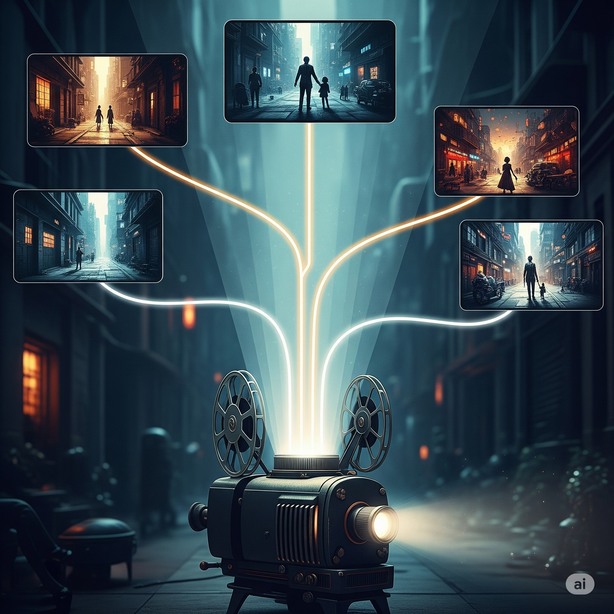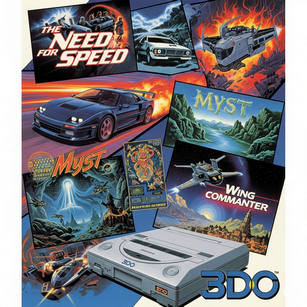INTERACTIVE CINEMA: HISTORY, TYPOLOGY, ARTISTIC TECHNIQUES
Relevance of the Research: Why is Interactive Cinema Important?
In recent decades, we have witnessed tectonic shifts in the creative industry. Digitalization and the rapid development of technology have brought interactive media to the forefront, confidently pushing traditional cinema and television from their leading positions. Interactive cinema, computer games, and art projects present new challenges for artists and scholars, demanding a rethinking of classic approaches to storytelling.
Despite growing attention to this topic, most research focuses on computer games, while interactive cinema is often considered only superficially. This work aims to fill this gap. Its goal is to define the place of interactive cinema in the modern media landscape, formulate clear criteria for its identification, and create a methodology for analyzing its interactive component.
Chapter 1: What is Interactive Storytelling? Theoretical Foundation
To understand the nature of interactive cinema, one must first turn to its foundation—the concept of interactive storytelling. The paper adopts Christian Roth’s definition: “Interactive storytelling is a computer-based interactive entertainment medium that allows users to intentionally influence a non-linear narrative mediated by a story engine.”
This definition highlights key aspects:
- Technological Basis: The medium exists on a computer-based platform.
- Social Aspect: Interactivity is viewed as communication between a human and a machine.
- Motivation: The primary goal for the user’s interaction is entertainment.
- Influence: The user is given the ability to affect the development of a non-linear narrative.
The history of interactive cinema officially begins in 1967 with the Czechoslovak director Radúz Činčera’s film “Kinoautomat” at Expo 67. Viewers could vote with remote controls on the plot’s direction, marking the first use of the “choice of action” interactive element in cinema.
The study of interactive storytelling is conducted in three main areas:
- Story Generation Mechanisms: The study of algorithms for constructing and managing the story.
- User Interaction: The development of interfaces and mechanisms that allow for active intervention in the plot.
- Story Dramatization: The search for artistic solutions to create compelling narratives.
Chapter 2: The Path of Evolution: From DVD to Game-Films
The second chapter traces the development trajectory of interactivity in cinema and games. The advent of CD and DVD technologies was a real breakthrough, allowing for the storage of large amounts of data and instant switching between scenes. This opened the door for projects like the animated game “Dragon’s Lair” (1983) and titles from American Laser Games, which used live-action video with real actors, such as “Mad Dog McCree” (1990).
DVDs introduced the ability to create interactive menus, allowing directors to experiment. For example, Michael Mann added a branching plot to the special edition of “The Insider” (1999), and the “Shrek” (2001) edition included a full game-journey through its fairy-tale world.
In parallel, interactive storytelling evolved in computer games. Narrativity, born from the influence of tabletop role-playing games (TTRPGs) like “Dungeon & Dragons” and text-based adventures, became a key element. This led to the emergence of new genres:
- Quest/Adventure: Games where plot progression is only possible by solving puzzles (“King’s Quest,” “Myst”).
- RPG (Role-Playing Game): Games with character creation and an emotional system for non-player characters (“Baldur’s Gate”).
- Game-Film: A genre aimed at providing a cinematic experience. Prominent examples include projects from the studio Quantic Dream (“Fahrenheit,” “Heavy Rain,” “Detroit: Become Human”).
Chapter 3: Practical Analysis: Where is the Line Between Cinema and Game?
The third chapter is dedicated to an experiment—an analysis of six modern projects in the “Full Motion Video Game” (FMV) genre. The goal was to check whether they meet the criteria for an interactive film. The analysis was conducted across three areas: the story creation mechanism, user interaction, and the cinematic-performative aspect.
Results of the analysis of some projects:
- “Super Seducer 2”: Although the project has a passive viewing option (“interactive cinema mode”), technical flaws prevent its full implementation. However, it meets the criteria for an interactive film, albeit with a need for refinement.
- “The Isle Tide Hotel”: This project is a prime example of an interactive film. Interactivity is organically woven into the visual and dramatic parts, creating seamless gameplay and focusing on delivering a cinematic experience.
- “Love Is All Around”: In this project, the gaming experience dominates, and there is no option for passive viewing. Therefore, it cannot be classified as an interactive film.
- “The Shapeshifting Detective”: This project is a quest-genre computer game. Game mechanics are the foundation, not an addition, and the main goal is to complete tasks, not to have a cinematic experience.
Main Conclusions and Scientific Novelty
- A definition of an interactive film is proposed: it is a medium that has seamless gameplay and allows for passive exploration of the plot, focused on providing a cinematic experience to the player.
- The line between cinema and game is defined: it lies in the experience the recipient gets (viewer vs. player).
- A methodology for analyzing an interactive film has been developed, which includes:
- Identifying the structure of the story implementation mechanism.
- Analyzing the interaction mechanisms.
- Describing the experience the viewer receives.
- Highlighting the interaction between the interactive, audiovisual, and dramatic components.
Prospects for further research lie in developing a specialized method of audiovisual analysis that considers the specifics of interactive storytelling and in expanding the analytical base for a deeper understanding of this unique medium.





